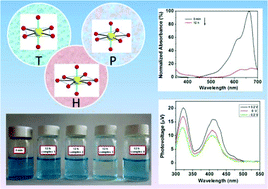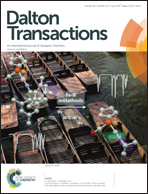A family of uranyl-aromatic dicarboxylate (pht-, ipa-, tpa-) framework hybrid materials: photoluminescence, surface photovoltage and dye adsorption†
Abstract
Four uranyl complexes [(UO2)(pht)H2O]·H2O (pht = phthalic acid) (1), (UO2)2(Hipa)4(H2O)2 (Hipa = isophthalic acid) (2), (UO2)(tpa)(DMF)2 (tpa = terephthalic acid) (3) and (UO2)(box)2 (box = benzoic acid) (4) were synthesized by the reaction of UO2(CH3COO)2·2H2O as the metal source and phthalic acid, isophthalic acid, terephthalic acid or benzoic acid as the ligand. They were characterized by elemental analyses, IR, UV-Vis, XRD, single crystal X-ray diffraction analysis and thermal gravimetric analysis. The structural analysis reveals that complex 1 exhibits a one-dimensional chain structure constructed by the building unit [(UO2)2(pht)4(H2O)2] and further extends the chain into a 2D supramolecular architecture by hydrogen bonding interactions. Complex 2 is a discrete [(UO2)2(Hipa)4(H2O)2] structure, and by the hydrogen bonding interaction, forms a 3D supramolecular structure. In complexes 3 and 4, adjacent uranyl polyhedra form a 1D chain through bridging terephthalic acid and benzoic acid, respectively. In order to extend their functional properties, their photoluminescence, surface photovoltage and dye adsorption properties have been studied.


 Please wait while we load your content...
Please wait while we load your content...